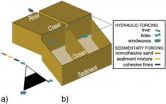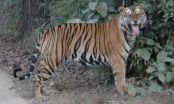(Press-News.org) T.rex hunted like a lion, rather than regularly scavenging like a hyena, reveals new research published in the journal Proceedings of the Royal Society B.
The findings end a long-running debate about the hunting behaviour of this awesome predator.
Scientists from the Zoological Society of London (ZSL) used an ecological model based on predator relationships in the Serengeti to determine whether scavenging would have been an effective feeding strategy for T.rex.
Previous attempts to answer the question about T.rex's hunting behaviour have focused on its morphology. The flaw in this approach is that two species can possess similar physical features and still have very different hunting strategies, such as vultures and eagles.
Lead author Dr Chris Carbone, says "By understanding the ecological forces at work, we have been able to show that scavenging was not a viable option for T.rex as it was out-competed by smaller, more abundant predatory dinosaurs.
"These smaller species would have discovered carcasses more quickly, making the most of 'first-come-first-served' opportunities."
Like polar bears and lions, the authors conclude that an individual T.rex would have roamed over large distances to catch its prey, potentially areas several times the size of Greater London.
This research now opens the door to look at the behaviour of T.rex as a hunter.
###
Notes for Editors
The paper 'Intra-guild competition and its implications for one of the biggest terrestrial predators, Tyrannosaurus rex' (DOI: 10.1098/rspb.2010.249) will be published online in Proceedings of the Royal Society B on Wednesday 26 January, 2011.
Founded in 1826, the Zoological Society of London (ZSL) is an international scientific, conservation and educational charity: our key role is the conservation of animals and their habitats. The Society runs ZSL London Zoo and ZSL Whipsnade Zoo, carries out scientific research at the Institute of Zoology and is actively involved in field conservation overseas. For further information please visit www.zsl.org
No leftovers for T. rex
2011-01-26
ELSE PRESS RELEASES FROM THIS DATE:
Researchers register new species using DNA-based description
2011-01-26
The previously unknown species of ribbon worm discovered in Kosterhavet National Park in 2007 has now been scientifically named using a new method. Pseudomicrura afzelii, a form of nemertean or ribbon worm, has been described and registered by researchers at the University of Gothenburg, Sweden, using DNA technology.
"We've shown that it's possible to move away from the traditional, highly labour-intensive way of describing a new species. Developments in molecular biology have made it possible to determine the genetic code for selected parts of DNA both quickly and cheaply." ...
A clearer picture of how rivers and deltas develop
2011-01-26
By adding information about the subsoil to an existing sedimentation and erosion model, researchers at Delft University of Technology (TU Delft, The Netherlands) have obtained a clearer picture of how rivers and deltas develop over time. A better understanding of the interaction between the subsoil and flow processes in a river-delta system can play a key role in civil engineering (delta management), but also in geology (especially in the work of reservoir geologists). Nathanaël Geleynse et al. recently published in the journals Geophysical Research Letters and Earth and ...
Insects that deter predators produce fewer offspring
2011-01-26
Scientists studied the defences used by caterpillars that transform into large white butterflies, called Pieris brassicae. The insects regurgitate semi-digested cabbage leaves to make them smell and taste unpleasant to predators. The team found, however, that frequent use of this defence reduces the caterpillars' growth rate and the number of eggs they produce. It remains unclear why their defences affect them in this way, but the loss of nutrition from frequent regurgitation is thought to play a part.
Caterpillars are a target of pest control, as they destroy food ...
Increased marginalization of students
2011-01-26
The successful Swedish model of reducing the impact of students' different social, cultural and economic backgrounds on academic outcome is severely threatened after 20 years of educational reforms. This is the main point made by Docent (Reader) Girma Berhanu from the University of Gothenburg in International Journal of Special Education.
Some of the previously very positive trends in the Swedish school system seem to have been put in reverse over the past 20 years, and students with special needs, immigrant students and socially disadvantaged students are getting the ...
A psychopath lacks empathy just like a person with frontal head injury
2011-01-26
"Seeing as psychopathic behavior is similar to that of a person with brain damage, it could be that it could benefit from similar forms of treatment," said Dr. Simone Shamay-Tsoory, who conducted the study.
People diagnosed as psychopathic have difficulty showing empathy, just like patients who have suffered frontal head injury. This has been shown in a new study from the University of Haifa. "Our findings show that people who have psychopathic symptoms behave as though they are suffering frontal brain damage," said Dr. Simone Shamay-Tsoory, who conducted the study.
Psychopathy ...
CSI: Manchester -- University team gets forensic on dinosaurs
2011-01-26
A new TV series featuring dinosaur detectives from The University of Manchester looking at how dinosaurs once lived, looked and functioned begins in the UK this week.
Presented by University of Manchester palaeontologist Dr Phil Manning, the series will be aired on the National Geographic Channel, starting in the UK on Thursday February 3rd, before being transmitted to many countries around the world.
It is the first ever series on dinosaurs commissioned by National Geographic, as previously documentaries have only aired as one or two-hour specials.
Jurassic CSI ...
Asian tiger numbers could triple if large-scale landscapes are protected
2011-01-26
The tiger reserves of Asia could support more than 10,000 wild tigers – three times the current number – if they are managed as large-scale landscapes that allow for connectivity between core breeding sites, a new study from some of the world's leading conservation scientists finds. The study, published in Conservation Letters, is the first assessment of the political commitment made by all 13 tiger range countries last November to double the tiger population across Asia by 2022.
"A Landscape-Based Conservation Strategy to Double the Wild Tiger Population" finds that ...
Patients infected with HIV have higher drop-out rate for liver transplantation
2011-01-26
French researchers determined that infection with human immunodeficiency virus (HIV) impaired results of transplant surgery for liver cancer, with more HIV infected patients dropping off the transplantation wait list. The team found that overall survival and recurrence-free survival was not impacted following liver transplantation in patients with controlled HIV disease. Details of this single center study—the largest to date—are published in the February issue of Hepatology, a peer-reviewed journal of the American Association for the Study of Liver Diseases (AASLD).
More ...
Researchers identify gene variants linked to hepatitis C treatment-related anemia
2011-01-26
In two recent studies, researchers have identified two functional variants in the inosine triphosphatase (ITPA) gene that protect patients with hepatitis C virus (HCV) against anemia brought on by antiviral treatment. The ability to identify those patients protected against treatment-induced anemia will ensure completion of antiviral therapy and successful elimination of the virus. Full findings of these studies appear in the February issue of Hepatology, a journal published by Wiley-Blackwell on behalf of the American Association for the Study of Liver Diseases.
Chronic ...
Climate tax on meat and milk results in less greenhouse gases
2011-01-26
A climate tax corresponding to €60/ton CO2eq on meat and milk could reduce
greenhouse gas emissions from European agriculture by around seven per cent. If the land made available is used for bioenergy production, the decrease in emissions can be six times greater. This is shown by the researchers Kristina Mohlin, Stefan Wirsenius and Fredrik Hedenus, University of Gothenburg, Sweden, in an article published in the scientific journal Climatic Change.
Kristina Mohlin is a PhD student at the Department of Economics at the University of Gothenburg. She wrote the article ...




